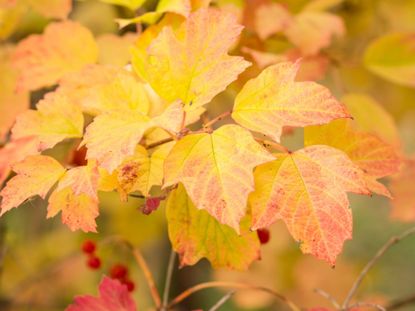Yellow Leaves On Viburnums: Reasons For Viburnum Leaves Turning Yellow


It’s impossible not to love viburnums, with their shiny leaves, showy blossoms and clusters of bright berries. Unfortunately, these gorgeous shrubs can be prone to certain pests and diseases, especially if growing conditions are less than ideal. Often, pests or disease are to blame when a viburnum has yellow leaves. Sometimes, treating viburnums with yellow leaves simply involves a few changes in plant care. If you notice viburnum leaves turning yellow, read on for a few troubleshooting tips.
Pests Causing Yellow Leaves on Viburnum
Aphids can cause big problems for viburnums, including puckered, yellowing leaves. Spray aphids with insecticidal soap spray every couple of days, but never when temperatures are over 85 F. (29 C.). A few drops of rubbing alcohol added to the soap mixture creates an even greater punch. Secondly, use bait stations to eliminate nearby ants, as they protect aphids so they have unimpeded access to their sweet honeydew excretion. Scale is evidenced primarily by the waxy, shell-like bumps that cover the pests. Like aphids, scale is usually controlled with a mixture of insecticidal soap and a small amount of rubbing alcohol. Thrips can also be a problem, leading to leaf yellowing of viburnum leaves. Often, regular pruning helps get rid of these pests, so cut off affected parts. Also, apply insecticidal soap or neem oil as soon as you see signs of damage. Root weevil adults feeding on foliage can be a problem, but it’s typically the larvae that cause pale green or yellow leaves on viburnum. Once again, insecticidal soap spray is an effective treatment, but a serious infestation may require use of chemical sprays. Be sure to spray the soil around the plants to kill root weevil adults in their daytime hiding places. Nematodes, tiny roundworms that live in the soil, may be the reason for viburnum leaves turning yellow. Dig a generous amount of composted leaves or other organic material into the soil around the plant to encourage beneficial bacteria that keeps roundworms in check. Pour fish emulsion around the plant to kill nematodes. Many gardeners plant marigolds around viburnum, as the roots tend to kill or repel nematodes.
Treating Diseased Viburnum with Yellow Leaves
Viburnum tends to be relatively disease-resistant, but they can be afflicted with various diseases. Here are a couple of problems to watch for: Leaf spot is a fungal disease that may cause blotchy, yellowing leaves on viburnum, especially during damp, cool weather. Remove and destroy damaged growth. Mulch around the shrub to keep water from splashing on the leaves. If the problem persists, apply a copper fungicide weekly during damp weather. Armillaria root rot is another fungus that commonly causes yellow leaves on viburnum, as well as a white fungal growth under the bark. The causes of armillaria root rot can be difficult to pinpoint and, currently, there is no treatment that guarantees control. However, proper plant care is critical. Thin the shrub to increase air circulation and be sure viburnum isn’t crowded too closely with other plants. Keep the shrub as dry as possible and don’t allow debris to build up at the base.
Gardening tips, videos, info and more delivered right to your inbox!
Sign up for the Gardening Know How newsletter today and receive a free download of our most popular eBook "How to Grow Delicious Tomatoes."

A Credentialed Garden Writer, Mary H. Dyer was with Gardening Know How in the very beginning, publishing articles as early as 2007.
-
 Clever Vertical Vegetable Garden Ideas For Small Spaces – 7 Ways To Save Space
Clever Vertical Vegetable Garden Ideas For Small Spaces – 7 Ways To Save SpaceShort on garden space? Learn some vegetable garden ideas for small spaces that are fun and easy.
By Mary Ellen Ellis
-
 26 Different Types Of Orchids – With Pictures & Information
26 Different Types Of Orchids – With Pictures & InformationDiscover stunning orchid types to grow in your home and garden – from easy beginner varieties to rare and exotic species that are the preserve of experts.
By Melanie Griffiths